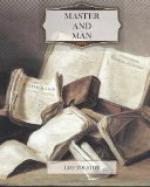|
This section contains 4,614 words (approx. 16 pages at 300 words per page) |

|
SOURCE: “Master and Man: Three Deaths Redivivus,” in American Contributions to the Eighth International Congress of Slavists, Volume 2: Literature, edited by Victor Terras, Slavica Publishers, 1978, pp. 260-70.
In the following essay, Heim perceives Master and Man as a reworking of Tolstoy's earlier work, Three Deaths.
Tolstoj's stories Three Deaths [Tri smerti, 1859] and Master and Man [Xozjain i rabotnik, 1895] stand equidistant from the years of his “conversion” and the autobiographical Confession [Ispoved', 1879]. In many respects Master and Man is a reworking of its predecessor. Tolstoj retains the basic structure of the early work while modifying its characters and situations to bring them into line with his new views of life and art.
In each of the stories three characters die. In Three Deaths they are Širkina, the wife of a landowner; Uncle Fedor, an old coachman; and a tree; in Master and Man—Brexunov, a prosperous innkeeper and land...
|
This section contains 4,614 words (approx. 16 pages at 300 words per page) |

|


